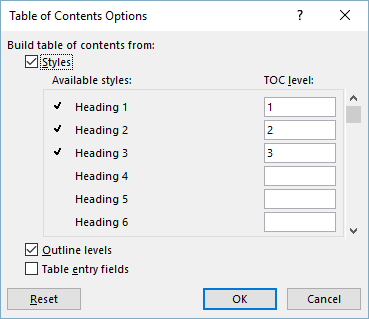

- HOW TO CREATE TABLE OF CONTENTS IN WORD WITH JUST HEADERS HOW TO
- HOW TO CREATE TABLE OF CONTENTS IN WORD WITH JUST HEADERS UPDATE
- HOW TO CREATE TABLE OF CONTENTS IN WORD WITH JUST HEADERS MANUAL
It’s not a perfect solution, but it works.
HOW TO CREATE TABLE OF CONTENTS IN WORD WITH JUST HEADERS UPDATE
If you modify any of the referenced documents, you might have to update the beginning page number of some, maybe all, of the documents. It might be a bit time-consuming if you have many documents. Best of all, Word includes hyperlinks to the various sections in your table of contents, so it isnt just a visual aid for printed documents, but its also perfect to make easy-to-browse online documents and PDFs with.
HOW TO CREATE TABLE OF CONTENTS IN WORD WITH JUST HEADERS MANUAL
That calls for a bit of manual manipulation, but it’s not difficult. For instance, in this case, I’d start the second document with the page number 2, instead of 1. When using this technique, you’ll probably want to alter the page-numbering scheme for all but the first document. That’s because both documents in this example have just one page, and I didn’t alter the page-numbering scheme for either – both documents begin with page number 1. If the control displays a field code instead of the table of contents, press + to update the field.In Word 2003, choose Reference from the Insert menu and then select Index and Tables.

Choose an option from the gallery options.In the Table of Contents group, click Table of Contents.Then, generate the table of contents as you normally would: A table of contents often abbreviated as TOC is what outlines the titles and/or gives a brief description of the first-level headers, second level headers or even third level headers in more. Reference files in the order of the content. Press Enter and repeat the above process for each document you want to include in the table of contents. Otherwise, be sure to enter the file’s full path.Īt this point, you won’t see anything, but don’t worry. Note: Table features are no longer available after you convert the table back to a range. OR- Right-click the table, then in the shortcut menu, click Table > Convert to Range. In the Tools group, click Convert to Range. If the document’s in the same folder as the table of contents document, check the Path Is Relative To Current Doc option. Click anywhere in the table and then go to Table Tools > Design on the Ribbon.In the Filename or URL control, enter the name of the first document you want to include in the table of contents.In Word 2003, choose Field from the Insert menu. Choose RD from the Fields Names list (RD stands for reference document).From the Quick Parts dropdown (in the Text group), choose Field.In the table of contents document, insert a Reference Document field for each document that you want to include in the table of contents, as follows: When you’re ready to build the table of contents, open a new document and save it using a descriptive name to identify it as a table of contents document.

This step isn’t necessary, but it simplifies things a bit. You’ll use fields in a separate table of contents document.īefore you start, if possible, save the documents that comprise the table of contents to the same folder. If you’re working with two or more documents, Word’s table of contents feature won’t work the same way, but it’s not impossible – it isn’t even hard.
HOW TO CREATE TABLE OF CONTENTS IN WORD WITH JUST HEADERS HOW TO
In the last blog post, I showed you how to generate a table of contents based on built-in heading styles. I is possible to create a single table of contents for multiple Word documents, it just requires an extra step or two. How to create one table of contents from multiple documents


 0 kommentar(er)
0 kommentar(er)
